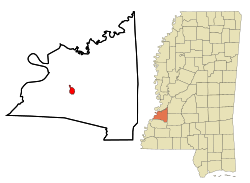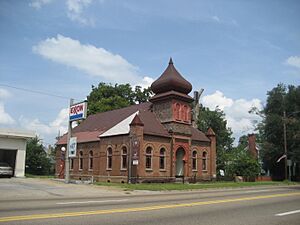Port Gibson, Mississippi facts for kids
Quick facts for kids
Port Gibson, Mississippi
|
||
|---|---|---|

Claiborne County Courthouse and Confederate monument in Port Gibson
|
||
|
||
| Motto(s):
"Too beautiful to burn"
|
||

Location of Port Gibson, Mississippi
|
||
| Country | ||
| State | ||
| County | Claiborne | |
| Area | ||
| • Total | 1.75 sq mi (4.55 km2) | |
| • Land | 1.75 sq mi (4.55 km2) | |
| • Water | 0.00 sq mi (0.00 km2) | |
| Elevation | 118 ft (36 m) | |
| Population
(2020)
|
||
| • Total | 1,269 | |
| • Density | 723.08/sq mi (279.18/km2) | |
| Time zone | UTC-6 (Central (CST)) | |
| • Summer (DST) | UTC-5 (CDT) | |
| ZIP code |
39150
|
|
| Area code(s) | 601 | |
| FIPS code | 28-59560 | |
| GNIS feature ID | 0676254 | |
Port Gibson is a city in Claiborne County, Mississippi, United States. It is the main town of Claiborne County, which is located next to the Mississippi River. In 2020, about 1,269 people lived there.
Port Gibson was first settled by French people in 1729. It was part of their large territory called La Louisiane. When the United States bought this land in 1803 (the Louisiana Purchase), Port Gibson officially became a town.
After Native American tribes were moved from the area, large cotton farms called plantations grew. Many enslaved African Americans were forced to work on these farms. By the time of the American Civil War, most people in the county were enslaved.
Port Gibson is known for its history, including events during the Civil War. Many of its old buildings are listed on the National Register of Historic Places. The city's motto, "Too beautiful to burn," comes from a famous quote by a Civil War general.
In the 1900s, Port Gibson was home to The Rabbit's Foot Company. This traveling show helped develop blues music in Mississippi. Today, the city has faced challenges as farming jobs have decreased, leading to a smaller population.
Contents
A Look at Port Gibson's Past
Port Gibson is one of the oldest European-American settlements in Mississippi. It started in 1729 with French colonists. Later, in 1763, the British took control of the area after a war.
The United States gained this land in 1803 through the Louisiana Purchase. Port Gibson officially became a town on March 12, 1803. In the 1830s, the U.S. government moved Native American tribes like the Choctaw and Chickasaw. This opened up their lands for new settlements.
Farmers then created large cotton plantations in the fertile river areas. They relied on the forced labor of enslaved African Americans. These enslaved people made up most of the county's population before the Civil War.
As the plantation owners became wealthy from cotton, they built schools. The Port Gibson Female College was founded in 1843 for their daughters. One of its buildings is now the city hall. Chamberlain-Hunt Academy, a military school, opened in 1879. It closed in 2014.
Port Gibson was a key location during the American Civil War. Union General Ulysses S. Grant fought here as part of his plan to control the Mississippi River. The Battle of Port Gibson happened on May 1, 1863. Over 200 soldiers died in this battle. The Confederate forces lost, which made it harder for them to defend Mississippi.
After the Civil War
Many historic buildings in Port Gibson survived the Civil War. This is because General Grant reportedly said the city was "too beautiful to burn." These words are now on the city's welcome sign.
Even after the war, cotton remained important. In 1882, the Port Gibson Oil Works opened. It was one of the first factories in the U.S. to process cottonseed oil. This historic factory closed in 2002.

The Gemiluth Chessed synagogue was built in 1892. It was used by Jewish immigrants who came from Germany. They started as traveling sellers and later became cotton traders. This synagogue is the oldest and only Moorish Revival style building in Mississippi. Over time, the Jewish population moved to bigger cities, and none remain in Port Gibson.
The Rabbit's Foot Company was started in 1900 by Pat Chappelle, an African-American theater owner. It was a very popular traveling show in the southern states. It featured an all-black cast of singers, musicians, and comedians.
After Chappelle died in 1911, Fred Swift Wolcott took over the company. He based the touring show near Port Gibson. The Rabbit's Foot Company stayed popular for many years.
In recent times, Port Gibson has seen its population decrease. This is partly because there are fewer farming jobs. The city's last major factory, the cottonseed mill, closed in 2002.
Port Gibson's Legacy
A Mississippi Blues Trail marker was placed in Port Gibson. It honors the Rabbit's Foot Company for its important role in developing blues music in Mississippi.
In 2006, an exhibit called The Blues in Claiborne County was held in Port Gibson. It showed the history of the Rabbit's Foot Company with old items and memories.
Historic Places to See
Port Gibson and its nearby areas have several historic sites. These are listed on the National Register of Historic Places.
- Van Dorn House: This house was finished around 1830. It was built by Peter Aaron Van Dorn, who was a lawyer and judge.
- McGregor: This house was designed in the Greek Revival style by Van Dorn for one of his daughters. It was completed in 1835.
- Windsor Ruins: These are 23 tall columns from a large plantation house that burned down around 1890. They are about ten miles southwest of the city and have appeared in movies.
- Wintergreen Cemetery: This is an old cemetery where many important people from Port Gibson are buried.
Geography and Climate
Port Gibson covers about 1.8 square miles (4.55 square kilometers) of land. It is located in Claiborne County, Mississippi.
The city has a warm climate. Summers are hot and humid, while winters are mild. It gets a good amount of rain throughout the year.
Population Changes
| Historical population | |||
|---|---|---|---|
| Census | Pop. | %± | |
| 1890 | 1,524 | — | |
| 1900 | 2,113 | 38.6% | |
| 1910 | 2,252 | 6.6% | |
| 1920 | 1,691 | −24.9% | |
| 1930 | 1,861 | 10.1% | |
| 1940 | 2,748 | 47.7% | |
| 1950 | 2,920 | 6.3% | |
| 1960 | 2,861 | −2.0% | |
| 1970 | 2,589 | −9.5% | |
| 1980 | 2,371 | −8.4% | |
| 1990 | 1,810 | −23.7% | |
| 2000 | 1,840 | 1.7% | |
| 2010 | 1,567 | −14.8% | |
| 2020 | 1,269 | −19.0% | |
| U.S. Decennial Census | |||
In 2020, there were 1,269 people living in Port Gibson. Most of the residents were African American (88.42%), and about 9.61% were White.
Schools in Port Gibson
The Claiborne County School District serves Port Gibson. Students attend Port Gibson High School.
The Chamberlain-Hunt Academy, a private military boarding school, used to be in Port Gibson. It opened in 1879 but closed its doors in 2014.
Famous People from Port Gibson
Many notable people have connections to Port Gibson:
- Pete Brown: A golfer who was the first African American to win on the PGA Tour.
- Henry Hughes: A lawyer and sociologist.
- Yolanda Moore: A former professional basketball player and coach.
- Irwin Russell: A well-known poet.
- J. D. Short: A Delta blues guitarist and singer.
- Earl Van Dorn: A Confederate general during the Civil War.
- Peter Aaron Van Dorn: A lawyer, judge, and one of the founders of Jackson, Mississippi.
- F. S. Wolcott: A minstrel show owner.
Images for kids
See also
 In Spanish: Port Gibson, Misisipi para niños
In Spanish: Port Gibson, Misisipi para niños




